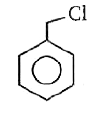Which of the following is Swart’s reaction?
C2H5Cl+AgFΔ−−→C2H5F+ Agcl
2C2H5Br+2Zn→(C2H5)2Zn+ZnBr2
2CHCl3+6Ag→CH≡CH+ 6AgCl
C2H5Br+Nal→C2H5I+NaBr
The correct Answer is:A
To determine which of the following is Swart’s reaction, we need to understand the characteristics of Swart's reaction and analyze the provided options step by step.
1. Understanding Swart's Reaction:
Swart's reaction involves the exchange of halogens, specifically the substitution of a halogen atom in an alkyl halide with a fluoride ion. This is typically done by heating an alkyl bromide or chloride in the presence of metallic fluorides such as AgF, Hg2F2, or BF3.
2. Analyzing the Options:
- Option 1: C2H5Cl + AgF → C2H5F + AgCl
- This reaction involves the substitution of chlorine (Cl) in ethyl chloride (C2H5Cl) with fluorine (F) from silver fluoride (AgF). This matches the description of Swart's reaction.
- Option 2: (not provided in detail but mentioned as incorrect)
- The reaction involves zinc and does not conform to the Swart's reaction criteria.
- Option 3: (not provided in detail but mentioned as incorrect)
- This option produces ethyne and does not yield a fluoride, which is not characteristic of Swart's reaction.
- Option 4: C2H5Br + NaI → C2H5I + NaBr
- This is an example of the Finkelstein reaction, where bromine is replaced by iodine, which does not align with Swart's reaction.
3. Conclusion:
Based on the analysis, Option 1 is the correct representation of Swart's reaction, as it involves the substitution of Cl with F in the presence of AgF.
Final Answer:
Option 1: C2H5Cl + AgF → C2H5F + AgCl is Swart's reaction.
---
Swart's reaction involves the exchange of halogens, specifically the substitution of a halogen atom in an alkyl halide with a fluoride ion. This is typically done by heating an alkyl bromide or chloride in the presence of metallic fluorides such as AgF, Hg2F2, or BF3.
- Option 1: C2H5Cl + AgF → C2H5F + AgCl
- This reaction involves the substitution of chlorine (Cl) in ethyl chloride (C2H5Cl) with fluorine (F) from silver fluoride (AgF). This matches the description of Swart's reaction.
- Option 2: (not provided in detail but mentioned as incorrect)
- The reaction involves zinc and does not conform to the Swart's reaction criteria.
- Option 3: (not provided in detail but mentioned as incorrect)
- This option produces ethyne and does not yield a fluoride, which is not characteristic of Swart's reaction.
- Option 4: C2H5Br + NaI → C2H5I + NaBr
- This is an example of the Finkelstein reaction, where bromine is replaced by iodine, which does not align with Swart's reaction.
Based on the analysis, Option 1 is the correct representation of Swart's reaction, as it involves the substitution of Cl with F in the presence of AgF.
Option 1: C2H5Cl + AgF → C2H5F + AgCl is Swart's reaction.
Topper's Solved these Questions
- HALOALKANES & HALOARENES BOOK - VMC MODULES ENGLISHCHAPTER - HALOALKANES & HALOARENES EXERCISE - ENABLE
99 Videos
- HALOALKANES & HALOARENES BOOK - VMC MODULES ENGLISHCHAPTER - HALOALKANES & HALOARENES EXERCISE - EFFICIENT
100 Videos
- ENVIRONMENTAL CHEMISTRYBOOK - VMC MODULES ENGLISHCHAPTER - ENVIRONMENTAL CHEMISTRYEXERCISE - JEE Main (Archive)
39 Videos
- HALOALKANES AND HALOARENESBOOK - VMC MODULES ENGLISHCHAPTER - HALOALKANES AND HALOARENESEXERCISE - IN-CHAPTER EXERCISE - F
6 Videos
Similar Questions
Knowledge Check
Which of the following is most reactive towardSN2 reaction ?
A B
B C
C D
D
Which of the following is most reactive towardSN2 reaction ?
ACH2=CH−CH2−ClBPh−CH2−ClC DPh−C∣∣O−CH2−Cl
DPh−C∣∣O−CH2−ClGiven below is a redox reaction. Which of the following types the reaction belongs to ?
CuSO4(aq)+Zn(s)→Cu(s)+ZnSO4(aq)ACombination reactionBDecomposition reactionCMetal displacement reactionDNon-metal displacement reaction
Swarts reaction.
View SolutionWhich of the following is are redox reaction(s) ?
View SolutionWhich of the following chemical reaction(s) is/are involved in developing of photographic plate?
View SolutionWhich of the following an reaction with H2S will produce metal sulphide?
View SolutionWhich of the following are SN2 reactions?
View Solution
